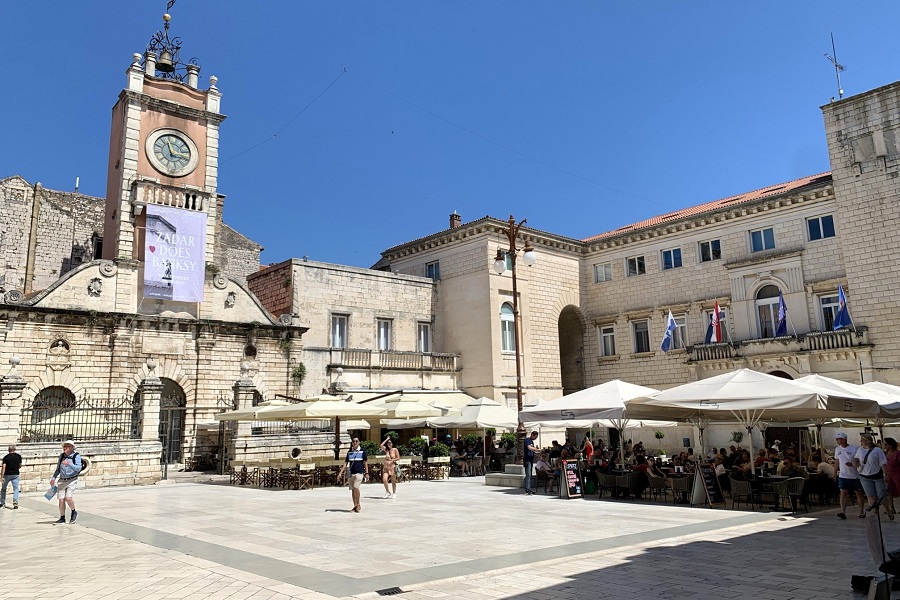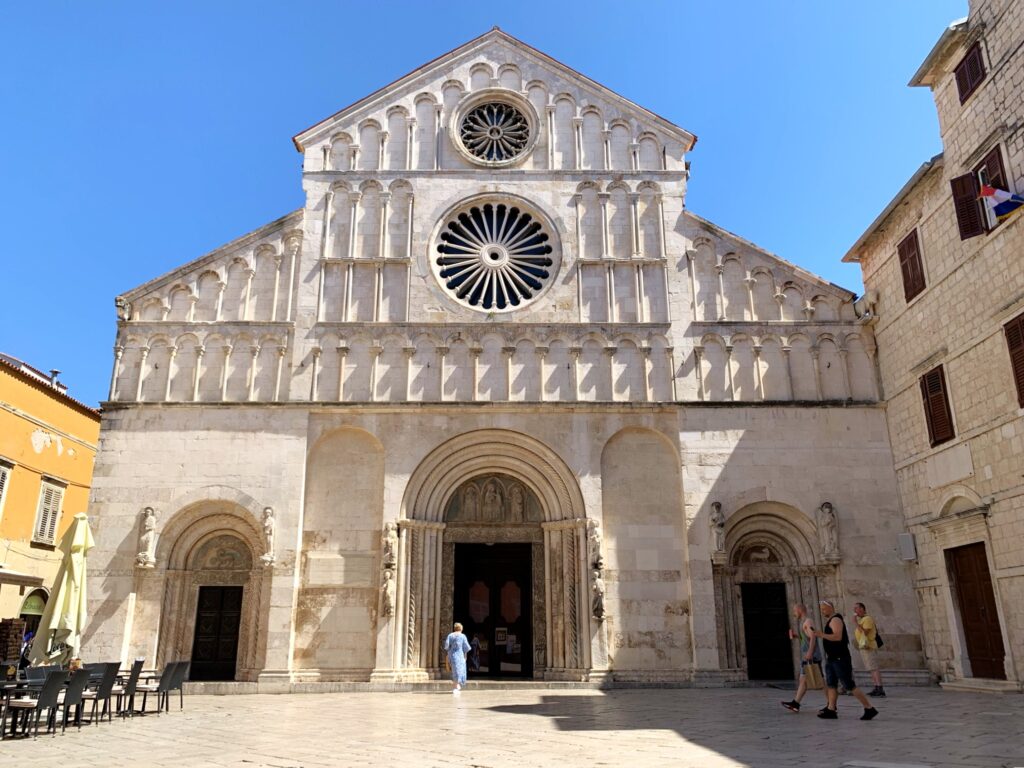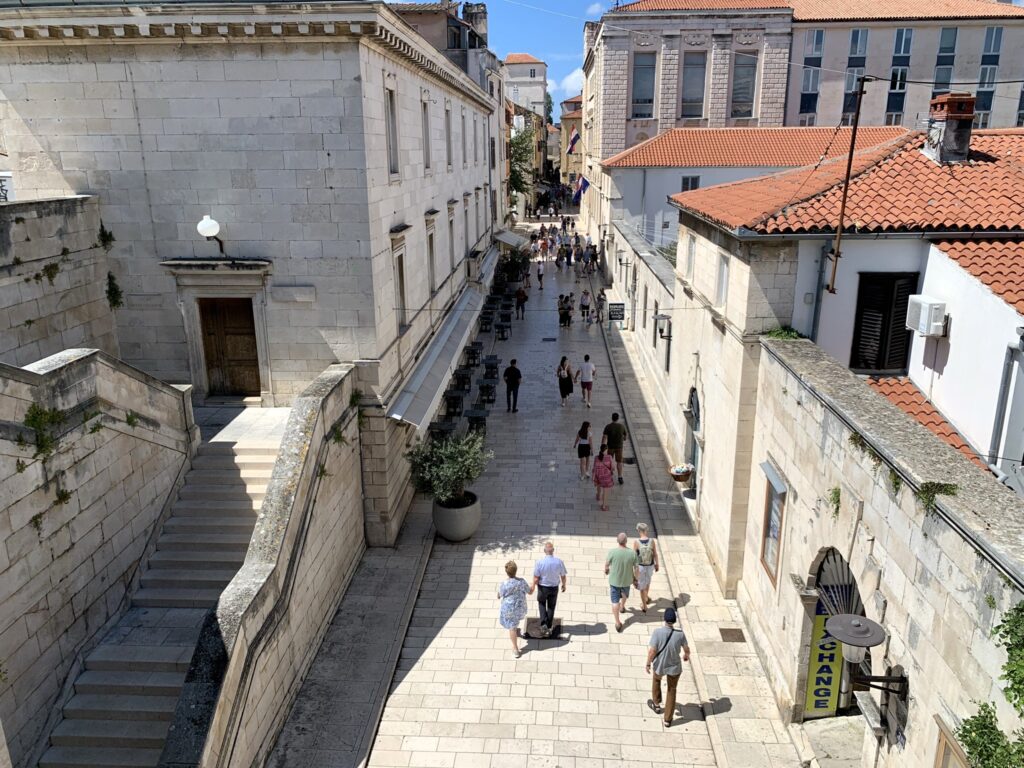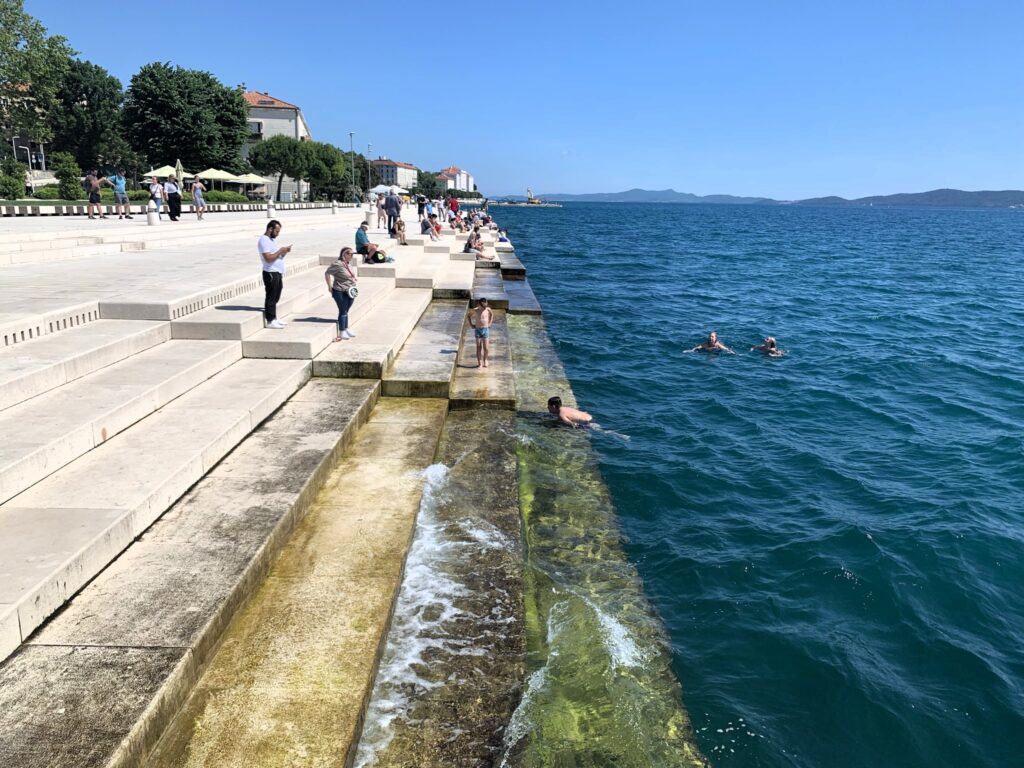Lapped by the Adriatic Sea, the old town of Zadar offers Mediterranean delights in a laid-back setting, with a plethora of Croatia’s islands and natural treasures at its doorstep.

The clock tower overlooking People’s Square (Photo: Andrea Gambaro for TravelMag.com)
The old town of Zadar occupies a small peninsula looking out over hundreds of islands and inlets, right in the middle of the Croatian coastline. It is served by an airport, and its wider territory includes major natural escapes such as Paklenica National Park. Despite the excellent location, this historic capital of Dalmatia is not as overrun with tourists as the likes of Split or Dubrovnik, which makes it an ideal choice for those wishing to experience local life beyond the sights and attractions.
A collection of landmarks spans the city’s history since ancient times, revealing traces left by the Romans, the Byzantines and the Venetians among others. Much has been lost to WWII bombings, and the modern architecture filling the gaps lends a discreet, understated tone to the urban landscape. Even when it comes to its most remarkable treasures, Zadar seems to simply showcase rather than boast. Original museums also form part of the cultural trail, while the contemporary vein of the city surprises visitors at the end of the seafront.
Things to do and see
Once the core of the city, the Roman Forum is where Zadar’s different facets gather all in one place. Adriatic scents pour from the seafront as visitors stroll around ancient stones and stumps of columns, which serve as a vivid introduction to the Archaeological Museum. Among the three churches looking on from the sidelines, St Donatus is the most impressive. Its round shape is a striking example of Byzantine architecture, often used as a scenographic music venue nowadays (events usually held in July and August). The neighbouring Cathedral of St Anastasia offers the best view over Zadar from the bell tower. It is also noted for its exquisite facade, rich artworks and marble sarcophagus enshrining the relics of the saint.

The Cathedral of St Anastasia (Photo: Andrea Gambaro for TravelMag.com)
The historic Land Gate is the city’s Renaissance masterpiece. It was built by the Venetians in 1537 as part of a wider upgrade of the ramparts, which marked a peak of the enduring conflict with the Ottoman Empire. The winged lion of St Mark, famously the Venetian symbol, dominates the outward side of the gate, framed by four Doric columns. It looks onto the charming Foša Harbour, a surviving stretch of the old moat. A walking path runs along the harbour and the Unesco-listed city walls. Once around the bastion, the path leads to the Neoclassicist building of the university.
This corner of the old town is home to the picturesque Varos neighbourhood, famous for its winding alleyways and tiny side streets. Here, working-class roots lie underneath a recent layer of boutiques, bars and restaurants, some of which are tucked away in typical Dalmatian courtyards (kaletas). Venture out to the edge of the neighbourhood to find the remains of the unusual key-shaped Church of Stomorica, part of a rich itinerary of historic churches scattered across the city (many are closed to visitors at the time of writing). The core of Zadar’s mystical vein, however, lies in the austere yet magnificent display of sacred art held at Saint Mary’s Monastery.

View from the New Gate (Photo: Andrea Gambaro for TravelMag.com)
Other cultural highlights include the Museum of Ancient Glass, the Arsenal, the Providur’s Palace and the Rector’s Palace. The last two palaces form part of a single complex thanks to renovation completed in 2022, establishing it as the city’s flagship venue for art, exhibitions and contemporary architecture.
To get acquainted with the local lifestyle, take a stroll down the Kelalarga (Wide Street), the main artery and beloved symbol of the city. Then spend some time in the main squares in typical Mediterranean fashion. The People’s Square was the town centre in Medieval times, while Peter Zoranić Square conveys a more leisurely vibe. The latter is named after the Zadar-born author of the first Croatian novel, a fictional travelogue across the nearby mountains (‘Planine’, 1569). From here, peek around the corner to find five wells built during the Ottoman siege of 1574. Another focal point of local life is the market situated along Pod Bedemom, formed by a colourful outdoor area and a covered section reserved for fish stalls.

The statue of the first Croatian novelist Petar Zoranić (Photo: Andrea Gambaro for TravelMag.com)
Elegant palaces and lush vegetation adorn the broad seafront, which replaced the old ramparts during the 19th century. What the city lost in historic landmarks, it gained in modern looks and spectacular sea views out to the islands of Ugljan and Pašman. The sunsets from here had a passionate advocate in Alfred Hitchcock, who famously said there are no better in the world. Towards the end of the promenade, graceful mermaid-like sounds reach passersby. This ‘Sea Organ‘ installation is a battery of 35 pipes set into the boardwalk steps, ‘played’ by the waves gently lapping away. Next to it, another contemporary installation pays visual homage to solar energy (‘Greetings to the Sun‘).
At the northeastern tip of the peninsula, experience a centuries-old tradition by being ferried across the marina on small rowing boats. Once on the other side, a short stroll leads to a curious stone-and-concrete statue depicting a Sphinx. It was built in 1901 to honour the deceased wife of a local artist and curator, and according to legend, it grants the visitors love wishes. Other attractions on the mainland include the local beaches: Kolovare is within a 15-minute walk of the old town, while Borik and Punta Bajlo take a bit longer to reach.

The Sea Organ (Photo: Andrea Gambaro for TravelMag.com)
Where to stay
Located a ten minutes’ walk from the old town, A’Mare Hotel (Ul. bana Josipa Jelačića 4A) provides straightforward comfort during a stay in Zadar. If the outside conveys a vaguely business-like feel, the interiors loosen up into a warm and contemporary atmosphere. Bright and spacious rooms feature simple design and modern fittings, the range includes a 33 sq.m. apartment for up to four people. Each booking comes with a lush buffet breakfast served in the lounge and restaurant area, where a stylish eight-metre bar takes centre stage. Brunch is served from 11am to 4pm, while dinner is often accompanied by live music.

The main hall at A’Mare (Photo: courtesy of A’Mare Hotel)
Particularly suited to couples and art lovers, Almayer (Ul. Braće Bersa 2) is a family-owned boutique hotel in Zadar’s old town. It comprises 16 rooms arranged across two heritage buildings recently restored. A modern, elegant design enhances the intimacy of the spaces. Communal areas include a secluded garden. The in-house art gallery displays a curated selection of contemporary works by Croatian and international artists, most of which are for sale. A sophisticated yet casual menu is served at the Corte Restaurant, where Dalmatian cuisine takes a contemporary and international twist. (The hotel has a 14+ adults-only policy.)
Art Hotel Kalelarga (Ul. Majke Margarite 3) is a design hotel seeking to embody the very essence of Zadar. Its 10 rooms are individually designed to evoke different aspects of the city’s heritage, from a majestic theatre that once stood nearby to the mighty Bura wind often sweeping across the streets. Each room offers a warm atmosphere thanks to soft colours and wooden furniture, while the top-range suite boasts a terrace. Mediterranean vibes meet Japanese cuisine at the on-site restaurant Nomu, resulting in a refined fusion enhanced by carefully selected wines.
Eat & Drink
Four centuries of Venetian rule left a tangible mark on the local cuisine, where Italian heritage meets Balkan and wider Mediterranean influences. A local tradition consists of baking under a domed lid covered in timbers (peka), but many other culinary experiences can be enjoyed across Zadar.
Meaning ‘tavern’, a konoba often indicates a simple place serving traditional food with no frills. It is the case at Konoba Tovar (Ul. Matice Dalmatinske 1), the direct descendant of a locally cherished joint whose fortunes relied on finely (and slowly) sliced Dalmatian prosciutto. While the prosciutto tradition lives on, the present-day tavern is also known for other specialities, such as fried whitebait. Expect a daily-changing special rather than long menus, and quick queues for the few seats available rather than reservations. Other taverns nearby offering an equally hearty experience include Konoba Dalmatina (Kovačka Ulica 10) and Konoba Stomorica (Stomorica ul. 5).
Maraschino and Pag cheese are the two flagship delicacies of Zadar. A world-famous cherry liquor the former, an artisan sheep cheese from the nearby island of Pag the latter. Both are available at Gligora Cheese & Deli (Hrvoja V. Hrvatinića 5). The shop is run by a prominent cheese-making family whose history intertwines with that of the Pag speciality. Spicy notes and a grainy texture are the main features of this product. In planning a trip to the island, consider a guided tour of the Gligora dairy. The deli is located next to Zadar’s market, whose stalls sell other takes on the famous cheese.
‘Eat and drink like a local’ might sound like an empty motto these days, but it is to be taken literally at the Wine Garden (Ul. pod bedemom 1A). Everything on the menu is produced in the region, from snacks and platters to a wide selection of wine. The joint is run by Ana Fiolić from the Fiolić winery, and it showcases a range of Dalmatian producers who have contributed to revamping the local winemaking culture in recent years. Cocktails and liquors are also served, including the famous Maraschino. Launched in 2022, the Wine Garden is housed in a charming courtyard next to Zadar’s main market. (Open from late Spring to early Autumn; wine tastings available.)

The Wine Garden found its home in the courtyard of a former church (Photo: Fabio Simicev / courtesy of Wine Garden)
Zadar Jadera (Ul. Brne Karnarutića 4) is an excellent choice to sample the local cuisine in a modern and intimate atmosphere. It is located next to St Chrysogonus church, and its name nods at the Roman history of the city. The menu revolves around meat and fish dishes, although veggie options are available. Try pašticada for something truly Dalmatian – slices of braised beef served with gnocchi. The black cuttlefish risotto is no less popular. Buzara-style seafood also features on the menu, along with many other regional specialities.
Fine dining in Zadar combines contemporary cuisine with ancient methods and family recipes. Kastel (Bedemi zadarskih pobuna 13) is the on-site restaurant of Hotel Bastion, located in a quiet corner of the old town. The menu features experimental dishes and Dalmatian classics, including black cuttlefish risotto and the widely celebrated local scampi (Velebit Channel Scampi). The same approach is found at Restaurant Foša (Ul. kralja Dmitra Zvonimira 2), with a stronger focus on fish and seafood. A sophisticated take on the dry-ageing technique is the house signature here, and the tasting menus are served on a waterside terrace with views on the old ramparts.

Foša Harbour (Photo: Andrea Gambaro for TravelMag.com)